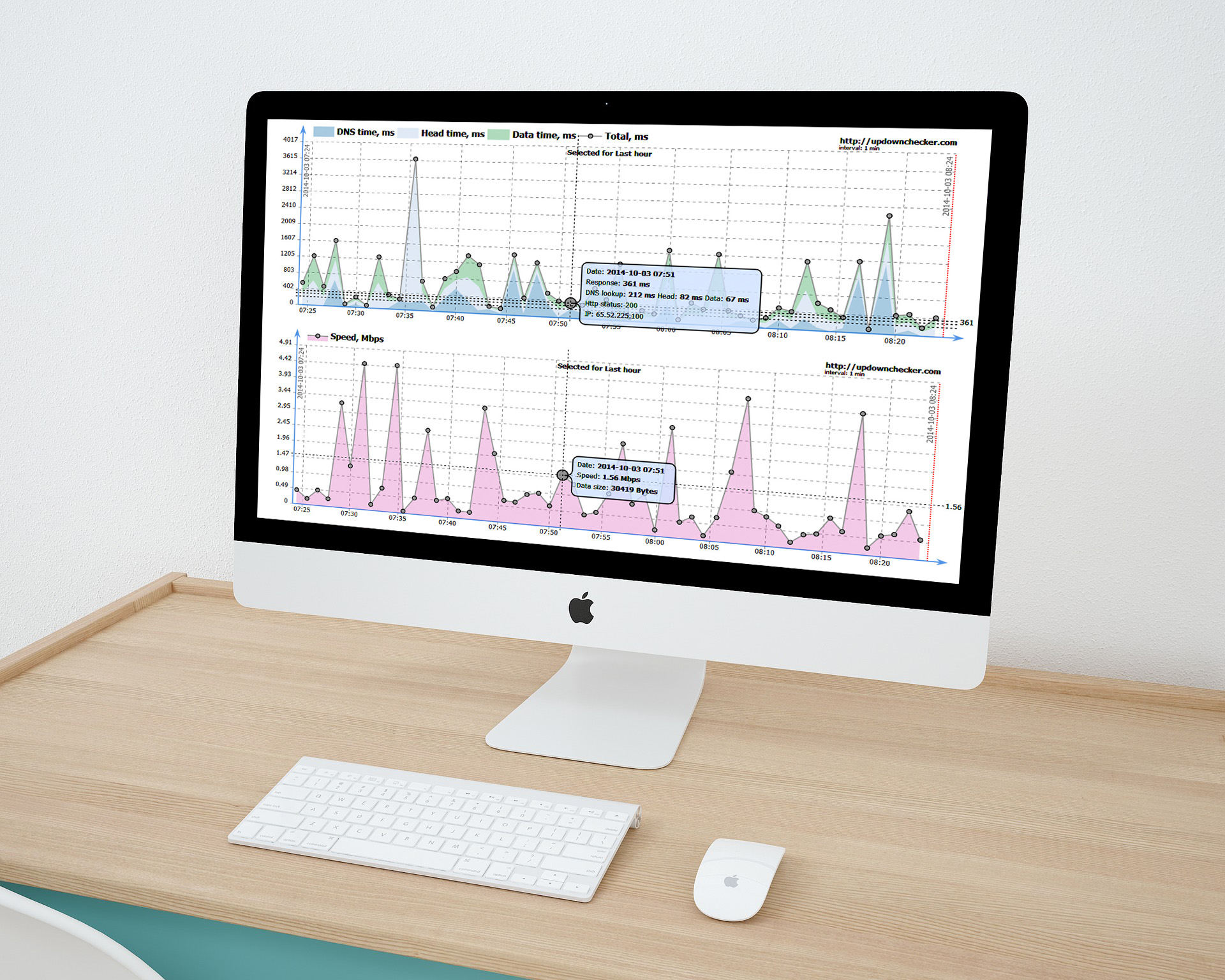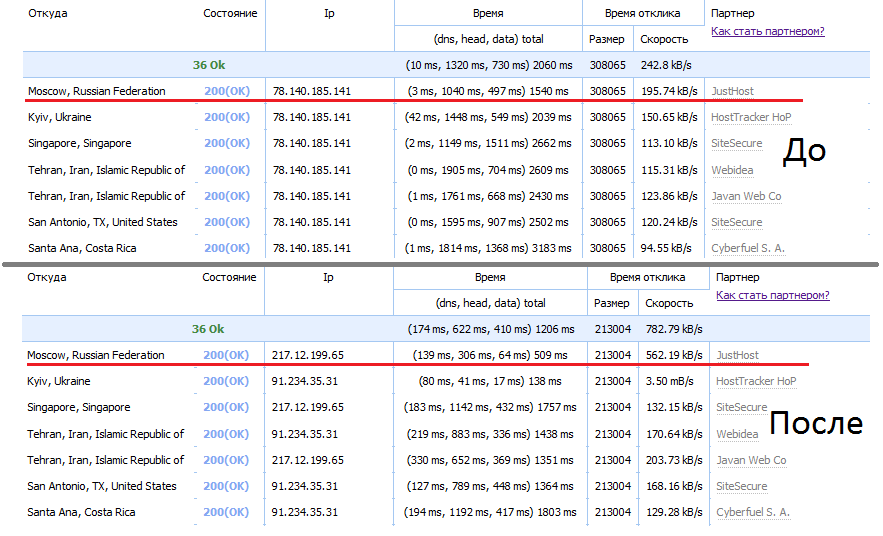Do you have a fast site? And if I check?
Search engines are intentional, and users intuitively evaluate websites by download time, and not only by the quality and relevance of the content. Recently, the indicator of the speed of the mobile version of the site has also become important. But, unlike content, it is more difficult to follow these parameters, especially if the target audience goes far beyond the limits of the native (for hosting) city. This publication will describe how this can still be done using the HostTracker site monitoring service and will consider one of the possible solutions to the problem.

Let's be honest: switching to a mobile-friendly version of the site is not easy for many. From the banal laziness, to simple analytics like “we have 93.4% of clients come from the desktop; why should we break our heads? ”But no, it turns out to be necessary anyway. Even if we discard the fact that the share of using the Internet from mobile devices is growing from year to year, it turns out that the speed of the mobile version also affects the rating of the site as a whole . Does the site look bad from the phone? Welcome from the first page of Google issue! Yandex did not make loud statements, but, by indirect evidence, it also does not lag behind.
Twice yes. The first "yes" concerns the search engines. Back in 2010, Google announced that the page loading speed will affect its place in the issue. However, it turned out not so simple. Independent studies have shown what they really meant in the company. So, since different sites are fundamentally different from each other in the number of downloadable content (even in the same sphere; there are no boundaries to creativity), it is difficult to compare them objectively. Perhaps that is why it is considered not all the time, but “loading the first byte”, that is, each site has it. And here just Google prefers those who have this first byte to the client faster. What does this time consist of? First, the time to determine the DNS. Secondly, the time to establish a connection with the server. And third, the actual transfer of the first byte (which are the page headers). For example, data from a real site, from which it is obvious that the transmission of the first byte just failed:
')

Now about the second "yes." It is from visitors. Some of them, quite possibly, got to the site through a search engine (so the first byte here is also mediocre "in the subject line"), but there are also those that follow links from other sites, from advertising and, of course, your old ones good regular customers. For all of them, without exception, the page as a whole is important, and if there are strong brakes here, then some of the visitors will leave immediately . With that irrevocably. That is, the total time is already underway: the first byte + content.
Very often, the greatest delay happens at the stage of page generation, which depends on the efficiency of the software on the web server and its load. Therefore, even if the download speed is on average acceptable, it happens that at certain peak moments it shamelessly drops, which we see on the screen above.
Actually, with the help of the HostTracker website monitoring service, you can both check once and make sure that everything is good or bad, and check the website on a regular basis. In this case, it is possible to control the response time by viewing the logs or even setting a special threshold, the load above which will also be considered an error:

Actually, the result of this check is shown in the first screenshot.
It is possible (and necessary) to choose hosting responsibly. Physical proximity to the target audience, as a rule, gives an advantage if this very audience is gathered more or less in one place. If not, it is recommended to use CDN systems. The essence of which is now not only in distribution (which reduces the time of the first byte), but also in the presence of the most modern software, clever caching algorithms and control over server load. That is, it serves both visitors and search engines. For example, after using this one for our tests, the load time was reduced so well:

But even a good hosting is desirable to control. Equipment and people change, and if you miss a few months ... Who knows where the competitors will be at this time.
As always, we will be glad to receive comments and suggestions for improving our service.

The trouble with mobile versions
Let's be honest: switching to a mobile-friendly version of the site is not easy for many. From the banal laziness, to simple analytics like “we have 93.4% of clients come from the desktop; why should we break our heads? ”But no, it turns out to be necessary anyway. Even if we discard the fact that the share of using the Internet from mobile devices is growing from year to year, it turns out that the speed of the mobile version also affects the rating of the site as a whole . Does the site look bad from the phone? Welcome from the first page of Google issue! Yandex did not make loud statements, but, by indirect evidence, it also does not lag behind.
Is this important?
Twice yes. The first "yes" concerns the search engines. Back in 2010, Google announced that the page loading speed will affect its place in the issue. However, it turned out not so simple. Independent studies have shown what they really meant in the company. So, since different sites are fundamentally different from each other in the number of downloadable content (even in the same sphere; there are no boundaries to creativity), it is difficult to compare them objectively. Perhaps that is why it is considered not all the time, but “loading the first byte”, that is, each site has it. And here just Google prefers those who have this first byte to the client faster. What does this time consist of? First, the time to determine the DNS. Secondly, the time to establish a connection with the server. And third, the actual transfer of the first byte (which are the page headers). For example, data from a real site, from which it is obvious that the transmission of the first byte just failed:
')

Now about the second "yes." It is from visitors. Some of them, quite possibly, got to the site through a search engine (so the first byte here is also mediocre "in the subject line"), but there are also those that follow links from other sites, from advertising and, of course, your old ones good regular customers. For all of them, without exception, the page as a whole is important, and if there are strong brakes here, then some of the visitors will leave immediately . With that irrevocably. That is, the total time is already underway: the first byte + content.
Keep abreast
Very often, the greatest delay happens at the stage of page generation, which depends on the efficiency of the software on the web server and its load. Therefore, even if the download speed is on average acceptable, it happens that at certain peak moments it shamelessly drops, which we see on the screen above.
Actually, with the help of the HostTracker website monitoring service, you can both check once and make sure that everything is good or bad, and check the website on a regular basis. In this case, it is possible to control the response time by viewing the logs or even setting a special threshold, the load above which will also be considered an error:

Actually, the result of this check is shown in the first screenshot.
What can be done? CDN as an option
It is possible (and necessary) to choose hosting responsibly. Physical proximity to the target audience, as a rule, gives an advantage if this very audience is gathered more or less in one place. If not, it is recommended to use CDN systems. The essence of which is now not only in distribution (which reduces the time of the first byte), but also in the presence of the most modern software, clever caching algorithms and control over server load. That is, it serves both visitors and search engines. For example, after using this one for our tests, the load time was reduced so well:

But even a good hosting is desirable to control. Equipment and people change, and if you miss a few months ... Who knows where the competitors will be at this time.
As always, we will be glad to receive comments and suggestions for improving our service.
Source: https://habr.com/ru/post/339236/
All Articles